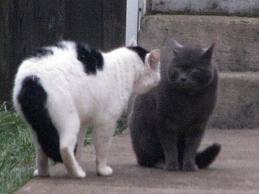Cats are most comfortable with routine. Sometimes, even the tiniest changes in your cat’s environment can upset her. Relocating her litter box, for example, can cause stress in her life. She may even act out by not using the litter box and instead, leaving little gifts throughout the house. Of course, this type of behavior and intolerance to change varies from cat to cat.
Generally, when big changes take place in the home, even the most aloof cats will inevitably experience some stress. If you’re planning a serious change, such as bringing a new cat home to a resident cat, it’s important to take certain measures in order for the introduction to be a harmonious one.
First Things First: Scent Exchange
 If possible, before bringing your new cat home, try to obtain something that belongs to him. A blanket works well, so does a toy. Leave the item around your resident cat. This enables your cat to become accustomed to the new cat’s scent.
If possible, before bringing your new cat home, try to obtain something that belongs to him. A blanket works well, so does a toy. Leave the item around your resident cat. This enables your cat to become accustomed to the new cat’s scent.
When you bring your new cat home, his scent won’t be so shocking to your resident cat. She will already be familiar with it. It’s also helpful if you can do the same for your new cat, as he will be undergoing the most upheaval.
Take It Slow: Settling In
Your new cat should be confined to a closed room or area of the home. Include a warm sleeping area, litter box, food, water, scratching post and other toys. Allow your new cat to set the pace. He may not be comfortable enough to leave his carrier for a while. On the other hand, he may hop right out and begin exploring. Neither cat should be aware of each other’s presence just yet.
The Big Switch: Scent Investigation
Your new cat will begin to feel more comfortable in his new environment. He may also begin to show interest in what’s out “there”. At this point, it’s a good idea to switch the cats without them seeing each other. Allow your new cat to investigate a larger portion of the house while leaving his scent around. Your resident cat should be guided into the new cat’s environment to sniff around. Do this for just a few minutes every day.
Our Smell: Building the Family Scent
It’s also helpful to rub a towel on one of the cats to pick up his scent. Then, rub the same towel on the other cat to pick up hers. This allows for the scents to intermingle and create a “family scent”. Continue rubbing the towel on each cat in an alternating fashion.
Sniffed but Not Seen: Meeting through the Door
Eventually, you can proceed to the next step. The best way to make the cats aware of each other for the first time is by way of food. Try placing their favorite meal or treats on opposite sides of the door that divides them.
When they take notice of each other without showing aggression, make sure to give each of them some extra-special treats. This way, they will begin to associate each other’s scent with something yummy and rewarding. After they’ve eaten their meals this way with no hissing or other aggressive behavior, then you may proceed to the next step.
First Physical Contact: Playtime through the Door
 A good transition to actual contact is to attempt play time through the door. You and a helper can play with each cat on opposite sides of the door. Then, encourage the cats to reach under the door with their paws to grab the toy. They may end up playing with each other’s paws. If any aggression is displayed, stop immediately and try again later.
A good transition to actual contact is to attempt play time through the door. You and a helper can play with each cat on opposite sides of the door. Then, encourage the cats to reach under the door with their paws to grab the toy. They may end up playing with each other’s paws. If any aggression is displayed, stop immediately and try again later.
“Oh, Hi”: The First Face-to-Face
Try replacing the solid door with something they can see through but can’t readily get at each other through. A baby gate, play pen, or a screen door work well. It’s important not to yell or raise your voice to correct behavior. This will only add to the stress of the situation and cause the cats to associate each other with negativity.
If aggression is displayed between the cats, simply revert to the solid door and try again at a later time. Always reward good behavior with treats and offer lots of love and pets for both cats.
Finally: Spending Some Time Together
 After at least a week or two of no signs of aggression, the cats may be ready to spend some time together without a barrier between them. This time should always be supervised. Try to get the cats together when they’re more likely to be calm, such as after eating or when they’re relaxing from playtime.
After at least a week or two of no signs of aggression, the cats may be ready to spend some time together without a barrier between them. This time should always be supervised. Try to get the cats together when they’re more likely to be calm, such as after eating or when they’re relaxing from playtime.
Make sure to reward good behavior. If you foresee any aggression or if either cat demonstrates signs of aggression, end the session and try again later. Again, don’t attempt to yell or correct inappropriate behavior with violence. A squirt bottle can be handy in instances when behavior must be corrected.
A Few Other Tips
- Make sure both cats are healthy, vaccinated and on parasite prevention so they don’t spread anything to each other.
- Understand that some cats just won’t get along. Some cats prefer to be solitary.
- Make their environment comfortable. This means lots of hiding spots and escape routes. Some cats like to sit up high and survey the land. Make sure there is enough cat furniture to facilitate their instincts.
- If you’re introducing more than one cat to a new cat, allow each resident cat to go through the process of introduction individually. After each cat is comfortable with the new cat, then you can let them spend time as a group. A hierarchy is naturally established within the group and each cat has their place. The new cat will learn his place within the group.
Thanks for visiting www.catdandruffclinic.com, if you liked this article please like us using the side bar. And for more reading check out the Top Cat skin disorders every pet owner should know about.



Comments are closed.